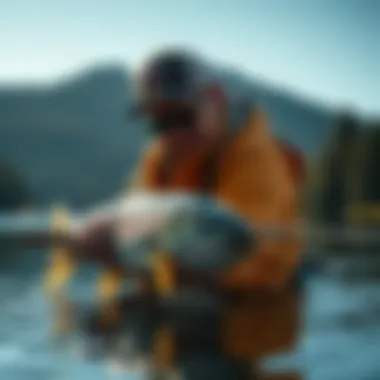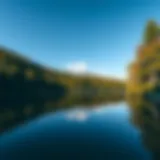Exploring Echo Lake Fishing: An In-Depth Examination


Intro
Fishing at Echo Lake is not just a pastime; it is an exploration of nature's delicate balance. As anglers descend upon this pristine haven, their experiences intertwine with the ecological tapestry that defines the area. Understanding the ecosystem and species diversity enhances the fishing adventure while underscoring the need for responsible practices. This article unpacks the environmental context of Echo Lake, the fishing techniques suited to its waters, and the cultural significance of this natural resource.
Forest Ecology and Biodiversity
Importance of Forest Ecosystems
The surrounding forests of Echo Lake are not only stunning vistas but function as crucial ecosystems that support local wildlife. Healthy forests play a key role in maintaining water quality, regulating climate, and providing habitat for various species, both aquatic and terrestrial. The interplay between forest and lake protects the biodiversity harbored within.
"The health of forests directly correlates to the richness of local fisheries. Without robust woodlands, the aquatic environment suffers greatly."
Flora and Fauna in Woodlands
The diversity in plant life surrounding Echo Lake contributes significantly to its fishing potential. Trees such as hemlock and red maple serve as natural filters, ensuring that the water remains clear and inviting for fish species. Furthermore, the underbrush supports various insects which, in turn, become a food source for both fish and birds.
Unquestionably, several specific species populate the region:
- Wildflowers like trillium and lady's slipper bloom in spring, attracting pollinators.
- Mammals such as deer and foxes roam the woods, and their presence contributes to the intricate food web.
- Birds like the great blue heron can often be spotted fishing along the wetlands.
The interconnectedness of these organisms holds profound implications for anyone engaging in fishing at Echo Lake. Anglers must be mindful that their practices affect not only fish populations but also the broader ecological community.
Sustainable Fishing Practices
Techniques for Responsible Management
Fishing here is not merely about casting a line and waiting. Knowledge of sustainable techniques is vital for preserving Echo Lake’s environment. Anglers are encouraged to follow certain practices:
- Catch and Release: Minimizing harm to fish populations enhances sustainability.
- Using Barbless Hooks: This reduces injury to fish.
- Adopting Seasonal Fishing: Respecting spawning seasons helps maintain fish reproduction rates.
The local regulations emphasize that sustaining the ecosystem requires effort from every angler. Those who fish must be aware of what they are removing from the waters.
Certification Schemes and Standards
To encourage responsible fishing practices, several organizations provide certification schemes. Programs like the Marine Stewardship Council promote sustainable seafood, helping businesses and consumers choose responsibly sourced fish. Adopting these practices not only secures the future of fishing at Echo Lake but resonates with a growing ethos of environmental stewardship around the globe.
Community Engagement and Stewardship
Role of Local Communities
Communities surrounding Echo Lake have increasingly recognized their role in conservation efforts. Their collective actions can spur substantial changes in maintaining the health of this natural resource. Local fishing clubs often organize educational workshops and clean-up initiatives to discuss sustainable fishing techniques and lake preservation.
Local insights reveal the cultural significance of the lake, where fishing creates bonds and traditions, connecting generations to the land. By working together, communities reinforce the importance of Echo Lake, prompting discussions around conservation and ecological responsibility.
Volunteer Opportunities for Engagement
For those who wish to deepen their involvement, volunteering offers an avenue for hands-on experience. Opportunities can range from participating in fish habitat restoration projects to assisting at local conservation events. Many organizations, like Trout Unlimited and The Nature Conservancy, have programs to engage volunteers willing to contribute to the rich ecosystem.
Such involvement not only enriches the community but also cultivates a deeper understanding of the lake's ecological dynamics.
Fishing at Echo Lake is a journey, one that requires not only skill but also knowledge and respect for nature. Understanding the interplay of ecology, sustainable practices, and community engagement lays the groundwork for a fishing experience that honors the beauty and vitality of this cherished resource.
Prelude to Echo Lake
Echo Lake isn't just another fishing hole; it's a tapestry of ecological and cultural significance woven into the land. For the angler or nature lover, the lake represents a blend of natural beauty, diverse wildlife, and community legacy. Understanding Echo Lake — its geography and history— not only enriches the fishing experience, but also underscores our responsibility to maintain this natural wonder for future generations.
Engaging with the lake requires a deeper comprehension of the environmental and social dynamics at play. The importance of this section lies in its potential to ground readers in the unique aspects of Echo Lake, guiding them into a more meaningful fishing experience. Whether it’s about the wind whispering through the trees or the ripples on the water, every detail adds to the allure. Moreover, by appreciating the fullness of Echo Lake, anglers can begin to evaluate how their actions today will shape the ecology of tomorrow.
Geographical Context
Nestled in the heart of a lush landscape, Echo Lake's geographical context is pivotal in shaping both its ecosystem and the fishing opportunities it provides. The lake sits at an altitude that lends itself to breathtaking vistas, and its surrounding terrain is a patchwork of dense forests, rocky outcrops, and wetlands. Such diversity in geography creates a home for various fish species and other wildlife, contributing to a balanced ecosystem.
"The location of Echo Lake plays a significant role in fish migration and feeding patterns; the unique topography limits access while enhancing natural habitats."
The lake itself is fed by mountain streams and runoff, keeping the water fresh and nutrient-rich. Seasonal changes also affect the water temperature, encouraging a variety of fishing techniques throughout the year. For those inclined to study local resource management, understanding the geographical layout helps illuminate why specific fishing periods are more fruitful than others.
Historical Significance


Delving into the past, Echo Lake serves as an important historical marker within the region offering insight into the cultural practices of its inhabitants over time. Indigenous peoples utilized the lake for its resources long before modern settlers arrived. These communities not only fished here but also constructed intricate lifestyles dependent on the lake's bounty, demonstrating a sustainable relationship with nature that is often overlooked today.
As we turned the pages of time, Echo Lake has witnessed the ebb and flow of recreational fishing trends, reflecting broader changes in environmental awareness and conservation efforts. Fishing festivals and community gatherings have sprung up around its banks, celebrating not just the catch of the day, but the bonds forged over shared experiences and conventions.
Understanding Echo Lake’s history is crucial for today’s anglers. It fosters appreciation for the recreational activities while raising awareness about indigenous practices that emphasized sustainable living. Whether it’s the whisper of a fishing line cast into the gentle waves or the thrill of reeling in a catch, each moment is immersed in a rich narrative that beckons respect and stewardship from those who enjoy the lake’s gifts.
Ecology of Echo Lake
The ecology of Echo Lake is a vital component of the overall fishing experience. Understanding the interplay between the lake's ecosystem and the aquatic life therein is essential not only for anglers but also for anyone interested in the health of natural resources. The balance of life—from the smallest micro-organisms to the larger fish species—plays a critical role in sustaining the lake's productivity and the surrounding environment. By appreciating the ecology, fishing enthusiasts can adopt better practices to ensure that this natural resource remains vibrant and sustainable for generations to come.
Flora and Fauna
Echo Lake is home to a diverse array of flora and fauna that contribute to its ecological richness. The vegetation in and around the lake includes a variety of aquatic plants, such as water lilies, cattails, and pondweeds. These plants not only provide habitat for fish and other aquatic wildlife but also contribute to the overall health of the water by absorbing excess nutrients and filtering pollutants.
The fauna is equally diverse. Fish species such as trout, bass, and panfish can be found in abundance, supported by a robust food web that includes insects, crustaceans, and smaller fish. Birds like herons and ducks frequently visit the lake, while mammals such as beavers and otters can be spotted along the shore, playing their part in maintaining ecological balance. This vibrant ecosystem reflects how intertwined each species is, emphasizing the importance of not only fishing regulations but also conservation efforts that protect these diverse organisms.
Water Quality Assessment
Assessing water quality is critical when evaluating Echo Lake's health and its ability to support both flora and fauna. Several factors impact the lake's water quality, including nutrient levels, temperature, and oxygen concentration—each playing a pivotal role in the aquatic ecosystem. Regular monitoring is essential for understanding how these elements interact and influence the diverse communities residing within the lake.
- Nutrient Levels: A proper balance of nutrients like phosphorus and nitrogen is necessary for plant growth; however, excessive amounts can lead to algal blooms, causing detrimental effects on fish populations and overall water quality.
- Temperature: The water temperature affects fish behavior, breeding, and metabolism. Cold-water species, such as trout, thrive in specific temperature ranges, while warmer water invites species that prefer different conditions.
- Oxygen Concentration: Oxygen levels are crucial for the survival of all aquatic life. Oxygen depletion can lead to fish kills and is often influenced by decomposition processes and physical disturbances in the water.
"The health of Echo Lake’s water is a reflection of our stewardship efforts. Monitoring and preserving water quality is imperative to maintain the life cycles within this ecosystem."
To ensure the ongoing quality of Echo Lake, continuous efforts in testing and monitoring by local environmental agencies are important. Anglers and community members can support these efforts by participating in clean-up days, advocating for responsible fishing practices, and staying informed about local initiatives that focus on maintaining the ecological integrity of this treasured lake.
By recognizing and respecting the intricate relationship between the lake's ecology and its fishery, we can foster a greater appreciation for Echo Lake and its surroundings—ultimately balancing enjoyment of fishing with the imperative for sustainability.
Fish Species at Echo Lake
When it comes to fishing at Echo Lake, understanding the variety of fish species present is not only essential for anglers but also crucial for maintaining the ecological balance of the area. Fish species serve as indicators of the health of aquatic ecosystems, and their diversity contributes to the overall vitality of the lake. This section emphasizes the specific elements that make the fish community at Echo Lake unique, offering insights into the benefits of these species and important considerations for fishing enthusiasts.
Common Species
At Echo Lake, anglers can encounter a notable mix of common fish species, each with its own characteristics and appeal. Here’s a closer look at these prevalent inhabitants:
- Rainbow Trout: Known for their vibrant colors and spirited fight, rainbow trout are a mainstay for local fishers. They thrive in the cool, well-oxygenated waters of the lake, making them a popular target, particularly in the spring and fall.
- Largemouth Bass: Easily recognizable, the largemouth bass can be found lurking in the lakeside vegetation and is admired for its size and aggressiveness. Renowned for being a favorite among sport fishermen, this species offers a challenge that many seek.
- Panfish (including Bluegill and Crappie): These smaller species provide great fun for newcomers to fishing and serve as an enjoyable target for families. Their numbers are significant, providing ample opportunity for a successful day of fishing.
Understanding these species can help anglers choose the right time and method for fishing. Knowledge about their habits and preferred habitats can lead to more productive fishing trips. Expert anglers often recommend using specific lures or baits depending on the species being targeted; for instance, spinning lures may entice largemouth bass, while worms are often favored for landing panfish.
Endangered Species and Conservation Efforts
The presence of endangered fish species at Echo Lake highlights the need for thoughtful conservation efforts. Among these, the Bull Trout stands out. Recognized for its declining populations, this species requires cold water habitats to thrive, making Echo Lake a critical area for its survival.
Conservation initiatives associated with Bull Trout and other endangered species in the region focus on several key efforts:
- Habitat Preservation: Maintaining and restoring the natural habitats around the lake ensures that conditions remain favorable for these vulnerable species.
- Public Education: Anglers and the local community are encouraged to engage in responsible fishing practices, including catch and release policies to help sustain populations.
- Research Collaborations: Partnerships with universities and environmental organizations aim to study the behavior and population dynamics of these less-common species. Findings can offer insights into broader ecological impacts and future measures needed for protection.
Engagement with these efforts is crucial not just for the fish, but also for future generations of anglers. As these endangered species face pressures from climate change and habitat loss, every action taken towards sustainability becomes a critical step in their conservation.
"Conservation isn’t just another word for management, it's a comprehensive approach involving community involvement, education, and ongoing research."
Through awareness and action, both local fishers and visitors can contribute to the resilience of our aquatic ecosystems.
Fishing Techniques
Fishing techniques play a pivotal role in every angler's experience at Echo Lake. A well-informed understanding of different methods not only increases the chances of success but also enhances the enjoyment derived from fishing. It’s important to recognize that the chosen fishing method may vary depending on several factors, such as the specific fish species targeted, environmental conditions, and even personal preferences. In essence, selecting the right technique can transform a simple fishing trip into an exciting adventure, filled with learning opportunities.
Freshwater Fishing Methods
Echo Lake is rich in diverse ecosystems that support a variety of fishing methods. Here are some popular freshwater fishing methods suited to the conditions of the lake:
- Casting: This is one of the most straightforward techniques. Anglers throw a baited hook or lure into the water and wait for a fish to bite. Various cast types, like overhead or sidearm, can be utilized depending on the desired distance or target area.
- Trolling: A technique often employed for larger species; here, boats slowly move through the water while dragging bait behind. This method allows for covering larger areas, which is helpful when searching for active fish.
- Bottom Fishing: This style targets fish species that dwell near the lakebed. By using heavier weights or sinkers, anglers can ensure their bait stays near the ground where fish like catfish or carp are known to lurk.
- Fly Fishing: A technique that truly requires finesse, fly fishing involves casting artificial flies designed to resemble insects. Mastering this method provides a unique experience, especially in areas where trout thrive.
As anglers navigate through these methods, they will find that each can be adapted based on the environment, time of year, and the individual fish species. With changing seasons, certain methods become more effective, making it crucial to stay informed about local fishing patterns and behaviors.
Tackle and Equipment Recommendations


The selection of tackle and equipment can be just as crucial as the fishing methods themselves. Here are some recommendations to consider when gearing up for a fishing trip to Echo Lake:
- Rods: A versatile spinning rod ranging from 6 to 7 feet is often deemed ideal for most applications. This length offers a balance between strength and flexibility.
- Reels: Opt for a quality spinning reel that offers smooth drag capabilities. A reel with a high gear ratio can prove advantageous for quickly reeling in fish.
- Line: A monofilament line with a strength of 8 to 12 pounds typically suffices for lake fishing. It provides a good balance of visibility and durability.
- Baits: Local bait shops often have insights on popular bait for Echo Lake. Recommendations often include live minnows, worms, or artificial lures that mimic local prey.
"Investing in the right equipment not only elevates your success rate but also your overall experience. Anglers who prioritize quality rod, reels, and lines often find greater enjoyment in their fishing endeavors."
- Safety Gear: Don’t forget life vests, sunscreen, and insect repellent, especially during summer months when the lake's insects are at their peak.
Understanding your tackle and tailoring your equipment to match the local conditions can make a world of difference. Reflection on personal comfort, control, and efficiency should guide every suggestion made for fishing tackle. Taking time to choose the right gear enhances your fishing experience significantly, helping foster a deeper appreciation for the sport and its demands. Furthermore, investing in tackle that suits the local conditions lays the foundation for sustainable fishing practices and community conservation efforts.
Regulations and Best Practices
When it comes to fishing in Echo Lake, understanding the regulations and best practices is not only prudent but essential for preserving the delicate balance of this ecosystem. Compliance with local laws ensures that the aquatic environment remains healthy and sustainable for both current and future anglers.
Local Fishing Regulations
Local fishing regulations vary from one area to another, often reflecting the specific needs of the ecosystem surrounding Echo Lake. These regulations are designed to manage fish populations and protect their habitats. Anglers must adhere to rules regarding fishing seasons, size and bag limits, and permissible fishing methods. The local wildlife agency regularly updates these guidelines, so it's wise to consult their websites or contact them directly for the most current info.
An important aspect of local regulations is the protection of certain fish species that may be vulnerable due to overfishing or environmental changes. For instance, trout may have a specific catch and release policy, while larger species like the Northern Pike might have restrictions on their harvest to ensure population sustainability. Local regulations can include:
- Limitations on the types of bait used, which can affect local wildlife.
- Restrictions on fishing in particular areas during spawning seasons to allow reproduction.
- Mandatory licensing requirements to promote responsible fishing.
Sustainable Fishing Practices
In addition to following local regulations, engaging in sustainable fishing practices is crucial. This not only aids in maintaining fish populations but also contributes to the overall health of Echo Lake. Sustainable practices include:
- Catch and Release: Releasing undesirable or out-of-season catches back into the water helps maintain population levels and allows fish to spawn and reproduce.
- Minimizing Disturbance: When fishing, try to limit noise and avoid trampling sensitive areas along the shore. This preserves the habitat for both fish and other wildlife.
- Selectively Harvesting Fish: Catching only what you can eat not only reduces overfishing but ensures that the ecosystem remains balanced.
"By practicing sustainable fishing, you protect Echo Lake for future generations – ensuring it remains a vital resource for both nature and anglers alike."
Moreover, participating in community initiatives or workshops focused on sustainable fishing can deepen one's understanding and commitment. Involvement in local events can facilitate valuable learning and foster a sense of community among anglers.
In sum, respecting local fishing regulations and committing to sustainable practices should be the guiding principles of every angler at Echo Lake. These measures reinforce the long-term viability of fish populations, ensuring that this cherished fishing locale thrives for generations to come.
Cultural Aspects of Fishing at Echo Lake
Fishing at Echo Lake transcends mere sport or recreation; it embodies a tapestry of traditions and community bonding that has evolved through generations. This section explores the cultural significance of fishing here, shedding light on how these practices enrich the lives of local residents, preserving a way of life that blends history, community values, and environmental stewardship. Their experiences at Echo Lake are often fewer about the catch and more about the connections formed with nature and one another.
Local Fishing Traditions
Local fishing traditions at Echo Lake showcase a profound respect for nature and a legacy passed down among families. For many long-time inhabitants, these practices are not just activity; they are a method to connect with their heritage.
Fishing Seasons: The fishing year often begins with the excitement of early spring, when local anglers gather to celebrate the opening of the season. This time is marked by local gatherings where tips are exchanged, and stories told. These rituals serve not only to replenish fishing knowledge but to strengthen community ties.
Traditional Techniques: Many seasoned anglers employ age-old techniques that prioritize sustainability. For example, locals might use specific types of bait that are in harmony with the ecosystem instead of more harmful methods. This care reflects deeply rooted values regarding the environment.
Folklore and Community Legends: Tales surrounding Echo Lake often stem from fishing adventures. Legends of prized catches, or of almost mythical encounters with fish that refuse to be caught, form the bedrock of local lore. These stories, often shared around campfires, serve to bond the community and engage younger generations, ensuring that fishing remains a cherished tradition.
Community Involvement and Events
Community involvement plays a crucial role in fostering a vibrant fishing culture at Echo Lake. Over the years, various events have formed a cornerstone of local life, emphasizing both the fun of fishing and the importance of preserving this natural resource.
Fishing Tournaments: Annual fishing tournaments attract both residents and visitors, stimulating interest in fishing while also boosting local economies. These events often promote friendly competition and encourage participants to practice ethical fishing—aligning with broader conservation goals.
"Whether you land a trophy fish or just enjoy the camaraderie, it’s the shared experiences that reel us in together."
Educational Workshops: Numerous local organizations host workshops aimed at instructing novices in fishing techniques, knot tying, and fish identification, alongside habitat protection strategies. These sessions often welcome families, thereby nurturing a future generation that values and respects Echo Lake’s ecosystems.
Cleanup Initiatives: Community clean-up days not only strengthen ties among neighbors but also ensure that Echo Lake remains pristine for future anglers. Local groups gather to rid the shores and waters of harmful debris, while also celebrating the beauty and biodiversity that Echo Lake supports.
These cultural aspects of fishing at Echo Lake reflect an ethos that prioritizes stewardship, community, and sustainability—a delicate balance that local anglers uphold with pride. The legacy of fishing at Echo Lake remains a vital part of the communal identity, attracting enthusiasts who seek to tap into a rich history while ensuring its survival for generations to come.
Economic Impact of Fishing
Fishing at Echo Lake isn’t just a pastime for enthusiasts; it’s a cornerstone of the local economy. This section delves into how fishing impacts tourism, local businesses, and economic stability in the region. Anglers flock to this venue, drawn not only by the rich aquatic life but also by the economic advantages they bring. Understanding the economic implications of fishing at Echo Lake reveals its essential role in sustaining the community.
Tourism and Local Economy


Fishing has a profound influence on tourism in the Echo Lake area. Every year, tourists venture into this picturesque location, enticed by the promise of a great catch and stunning natural vistas. This influx of visitors stimulates various sectors:
- Accommodation: Many tourists opt for local lodgings, from quaint bed and breakfasts to larger hotels. The need for places to stay brings business and income to hospitality sectors.
- Restaurants and Cafes: After a long day of casting lines, visitors often seek dining options. Local eateries that serve fresh catches or comfort food capitalize on hungry anglers, leading to increased sales and employment.
- Local Guides and Charters: Anglers often seek expert guidance to optimize their fishing. Local fishing guides and charter services flourish as they provide knowledge and tools, enhancing the fishing experience while contributing to the local economic landscape.
Not to forget, special events like fishing tournaments draw additional crowds, further enhancing revenue for locals. These tournaments not only attract participants but also spectators eager for a weekend of excitement, showcasing the symbiotic relationship between fishing and tourism.
Fishing Licenses and Revenue Generation
In a framework encouraging sustainable fishing, licensing serves as a crucial tool. Fishing licenses contribute significantly to the funds needed for conservation and maintenance of fishing grounds. Here’s how:
- Funding Conservation Efforts: Revenue from fishing licenses often flows into initiatives aimed at preserving aquatic habitats. This ensures a balanced ecosystem, allowing fish populations to thrive for years to come.
- Enhancing Infrastructure: The funds generated can be directly used for enhancing fishing infrastructure, such as maintaining boat launches and providing clean, accessible shorelines for public use.
- Regulatory Bodies Support: The revenue helps governmental and nonprofit organizations implement and enforce local fishing regulations, ensuring that fishing remains viable and sustainable.
The value of fishing licenses transcends mere legal requirements; rather, they symbolize an investment in the local ecology and the community. As a result, each license purchased reflects a commitment to the environment and the future health of Echo Lake.
"Fishing licenses symbolize more than a ticket; they’re a lifeline for conservation efforts, connecting anglers to the health of local ecosystems."
In summary, the economic impact of fishing at Echo Lake extends far beyond the immediate catch. It weaves a fabric of tourism, local enterprise, and ecological stewardship that fortifies the region. Recognizing these connections helps cement fishing as a vital part of the community’s identity and prosperity.
For further insights on local fishing initiatives or to learn more about conservation efforts, visit National Park Service and EPA.
Challenges Facing Echo Lake Fishing
Fishing at Echo Lake presents more than just the thrill of reeling in a catch. It embodies the delicate balance between enjoying a bountiful resource and grappling with the numerous challenges that threaten its viability. The importance of addressing these challenges cannot be understated. A well-informed angler must navigate the complexities surrounding environmental changes and the risks of overfishing, recognizing their role in conservation and sustainability. This knowledge fosters significant benefits not only for the fishing community but for the ecosystem as a whole, highlighting the interconnectedness of nature and human activity.
Environmental Changes
Environmental changes pose a considerable threat to Echo Lake's fragile aquatic ecosystem. Factors such as climate change, pollution, and habitat alteration can significantly affect water quality, fish populations, and biodiversity. The increasing temperatures can lead to lower oxygen levels in the water, impacting fish behavior and reproduction. Additionally, runoff from agricultural activities may introduce harmful chemicals to the lake, compromising the health of native species.
Anglers should be aware of these risks. Monitoring environmental data can provide insights into when and how to fish responsibly. Participation in local conservation programs that aim to mitigate pollution and enhance habitat restoration is key. Sustainable fishing practices serve not only to protect fish populations but contribute to the overall health of the lake and surrounding ecosystem.
"Protecting our natural resources today ensures that future generations can enjoy the same beauty and opportunities we cherish."
Overfishing Risks
The pressing issue of overfishing looms large over Echo Lake. As anglers flock to this aquatic haven, the number of fish caught can exceed sustainable levels. When a species is fished at a rate faster than it can reproduce, the population declines sharply. This not only disrupts the balance within the lake but also diminishes the fishing experience for everyone involved. The decline of species can lead to unforeseen consequences, such as the proliferation of invasive species that threaten native fish.
To combat overfishing, strict adherence to local regulations regarding catch limits and seasonal restrictions is crucial. Profound awareness and education about the species that are most susceptible to overfishing empower anglers to make informed decisions. Moreover, community-led efforts like catch-and-release programs can bolster fish populations, ensuring a viable fishing environment for the long haul.
In summary, understanding the challenges posed by environmental changes and overfishing is pivotal for anyone engaging in Echo Lake fishing. Not only does this knowledge cultivate a deeper appreciation for the ecosystem, but it also reinforces the responsibility that comes with being an angler in this beautiful region.
Community Stewardship Initiatives
Community stewardship initiatives around Echo Lake play a pivotal role in sustaining not only the fishing economy but also the ecological health of this cherished habitat. By harnessing local knowledge and promoting active participation, these initiatives foster a sense of responsibility toward nature, while simultaneously preserving the delicate balance of the aquatic ecosystem. Such efforts ensure that future generations can enjoy the rich biodiversity and fishing experiences that Echo Lake offers today.
Conservation Projects
Conservation projects at Echo Lake involve a variety of efforts aimed at restoring and maintaining the natural environment. For instance, habitat restoration initiatives focus on replanting native vegetation to combat erosion and improve water quality. These projects are often supported by local environmental groups and government agencies, ensuring a concerted effort toward ecological conservation. Here are some notable projects:
- Wetland Restoration: This project aims to enhance the surrounding wetlands that play an essential role in filtering pollutants and providing habitat for diverse wildlife. By restoring these areas, the projects not only improve water quality but also increase fish spawning success.
- Invasive Species Management: Another critical initiative involves the removal of invasive species that threaten to outcompete native flora and fauna. Regular monitoring and removal efforts significantly benefit native fish populations by preserving their natural habitats and food sources.
"The health of the lake directly correlates with the sustainability of fishing practices, highlighting the importance of conservation initiatives."
Volunteer Programs and Engagement
Volunteer programs create an essential link between the community and the lake, allowing individuals to engage directly with the stewardship of this resource. These programs offer a hands-on approach for community members to contribute to maintaining the ecological integrity of Echo Lake.
- Lake Clean-up Days: Regular clean-up events invite locals and visitors to help remove trash and debris from the shores and waters of Echo Lake. This not only enhances the scenic beauty of the area but also helps protect habitats critical for fish and other wildlife.
- Educational Workshops: Organizing workshops on sustainable fishing practices and the importance of biodiversity educates community members. These gatherings provide a platform for sharing knowledge about the lake's ecosystem, stirring awareness about the impact of fishing activities and conservation needs.
- Youth Engagement Programs: Specific initiatives aimed at youth encourage the next generation to take an interest in their environment. Programs that teach fishing skills alongside ecological education instill a sense of pride and responsibility toward the lake.
By participating in these programs, community members not only contribute to Echo Lake’s health but also strengthen their ties to nature and their neighbors.
In summary, community stewardship initiatives create a holistic approach to maintaining the Echo Lake ecosystem. They blend conservation projects with active community engagement, ensuring that sustainable practices and awareness spread through generations, thereby protecting the lake for years to come.
Closure
Reflecting on the discussions throughout this article, it's crucial to understand the lasting significance of focusing on sustainable fishing practices at Echo Lake. Balancing ecological preservation with fishing activities isn't just a nice-to-have; it's essential for ensuring the longevity of this aquatic ecosystem, which countless local and visiting anglers cherish.
Reflection on Sustainable Practices
Sustainable fishing practices are fundamental to maintaining the delicate balance between human enjoyment and environmental health at Echo Lake. Here are several key considerations that highlight why these practices are so significant:
- Biodiversity: By prioritizing sustainable methods, we help to protect the diverse fish species that inhabit Echo Lake, ensuring that future generations can enjoy fishing in a thriving ecosystem.
- Ecosystem Health: Healthy fish populations contribute to the overall stability of the lake's ecological system. Unsustainable practices can lead to overfishing, which disturbs not just fish but a whole web of life that depends on them, including aquatic plants and other wildlife.
- Community Engagement: Encouraging sustainable fishing promotes a culture of stewardship within the fishing community. When local anglers are engaged in practices that benefit the lake, they become invested in its health and future, creating a more vibrant and supportive community atmosphere.
- Regulatory Compliance: Abiding by established fishing regulations is crucial. These regulations are usually rooted in scientific research aimed at preserving fish populations and habitats. Anglers should always be aware of the rules in place and engage in practices that comply with them.
- Education and Awareness: Finally, advocating for sustainable practices raises awareness, informing both seasoned fishermen and novices about the best approaches. Knowledge is power, and sharing information about sustainable techniques can lead to a ripple effect, encouraging more responsible fishing habits.
"Exactly as we care for the water today, the water will care for us tomorrow."
For additional insights on sustainable fishing techniques and regulations, consider visiting resources such as NOAA Fisheries or the Environmental Protection Agency.















